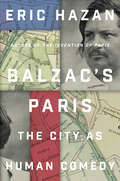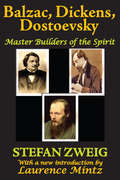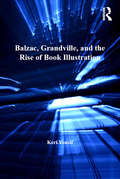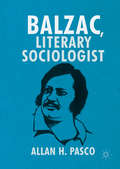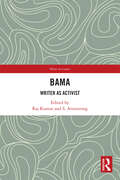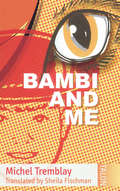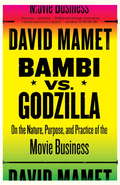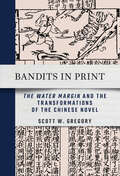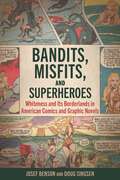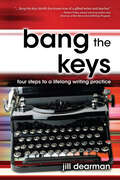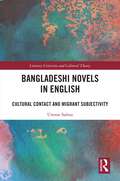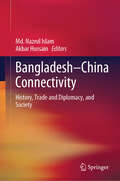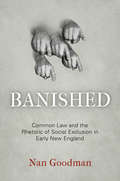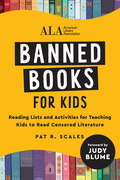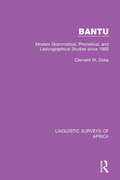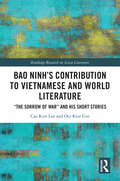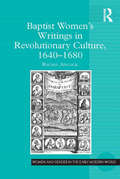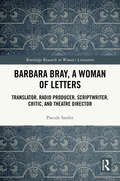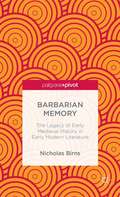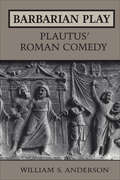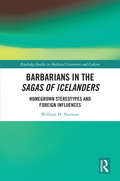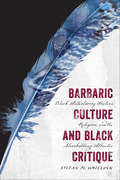- Table View
- List View
Balzac's Paris: The City as Human Comedy
by Eric HazanExploring Paris arm in arm with Balzac, nineteenth-century France&’s most famous novelist and observerIn Balzac&’s vast Human Comedy, a body of ninety-one completed novels and stories, he endeavoured to create a complete picture of contemporary French society and manners. Within this work is a loving ode to Paris and an incomparable introduction to the first capital of the modern world.To this ageless city he makes a declaration of love in an accumulation of finely observed detail – the cafés, landmarks, avenues, parks – and captures the populace in countless meticulously drawn portraits: its lawyers, grisettes, journalists, concierges, usurers, salesmen, speculators.Balzac gathered the elements of this Paris by sauntering through it. &‘To saunter is a science,&’ he writes, &‘it is the gastronomy of the eye. To take a walk is to vegetate; to saunter is to live.&’ Eric Hazan follows in Balzac&’s footsteps, criss-crossing the city in the novelist&’s outsize boots, running between printers, publishers, coffee merchants, mistresses and friends, stopping for a moment, struck by a detail that would be fixed in Balzac&’s photographic memory.More than a tour of the city, Balzac&’s Paris is an attempt to measure the soul of a city as recovered in its finest literature.
Balzac, Dickens, Dostoevsky: Master Builders of the Spirit
by Stefan ZweigWritten over a period of twenty-five years, this first volume in a trilogy is intended to depict in the life and work of writers of different nationalities--Balzac, Dickens, and Dostoevsky--the world-portraying novelist. Though these essays were composed at fairly long intervals, their essential uniformity has prompted Zweig to bring these three great novelists of the nineteenth century together; to show them as writers who, for the very reason that they contrast with each other, also complete one another in ways which makes them round our concept of the epic portrayers of the world.Zweig considers Balzac, Dickens, and Dostoevsky the supremely great novelists of the nineteenth century. He draws between the writer of one outstanding novel, and what he terms a true novelist--an epic master, the creator of an almost unending series of pre-eminent romances. The novelist in this higher sense is endowed with encyclopedic genius, is a universal artist, who constructs a cosmos, peopling it with types of his own making, giving it laws of gravity that are unique to these fi gures.Each of the novelists featured in Zweig's book has created his own sphere: Balzac, the world of society; Dickens, the world of the family; Dostoevsky, the world of the One and of the All. A comparison of these spheres serves to prove their diff erences. Zweig does not put a valuation on the differences, or emphasize the national element in the artist, whether in a spirit of sympathy or antipathy. Every great creator is a unity in himself, with its own boundaries and specifi c gravity. There is only one specifi c gravity possible within a single work, and no absolute criterion in the sales of justice. This is the measure of Zweig, and the message of this book.
Balzac, Grandville, and the Rise of Book Illustration
by Keri YousifExamining how the rise of book illustration affected the historic hegemony of the word, Keri Yousif explores the complex literary and artistic relationship between the novelist Honoré de Balzac and the illustrator J. J. Grandville during the French July Monarchy (1830-1848). Both collaborators and rivals, these towering figures struggled for dominance in the Parisian book trade at the height of the Romantic revolution and its immediate aftermath. Both men were social portraitists who collaborated on the influential encyclopedic portrayal of nineteenth-century society, Les Français peints par eux-mêmes. However, their collaboration soon turned competitive with Grandville's publication of Scènes de la vie privée et publique des animaux, a visual parody of Balzac's Scènes de la vie privée. Yousif investigates Balzac's and Grandville's individual and joint artistic productions in terms of the larger economic and aesthetic struggles within the nineteenth-century arena of cultural production, showing how writers were forced to position themselves both in terms of the established literary hierarchy and in relation to the rapidly advancing image. As Yousif shows, the industrialization of the illustrated book spawned a triadic relationship between publisher, writer, and illustrator that transformed the book from a product of individual genius to a cooperative and commercial affair. Her study represents a significant contribution to our understanding of literature, art, and their interactions in a new marketplace for publication during the fraught transition from Romanticism to Realism.
Balzac, Literary Sociologist
by Allan H. PascoMelding the fields of literature, sociology, and history, this book develops analyses of the ten novels in Balzac's Sc#65533;nes de la vie de province. Following the order of the novels projected in La Com#65533;die humaine, Allan H. Pasco investigates how Balzac used art as a tool of social inquiry to obtain startlingly accurate insights into the relationships that defined his turbulent society. His repeated claim to be an "historian of manners" was more than an empty boast. Though Balzac was first and foremost a great novelist, he was also a trailblazing sociologist, joining Henri de Saint-Simon and the subsequent Auguste Comte in considering the relationships that represent society as an interacting, interlocking web. Using a methodology that combines close analysis with a broad cultural context, Pasco demonstrates that Balzac's sociological vision was extraordinarily pertinent to both his and our days.
Bama: Writer as Activist (Writer in Context)
by Raj Kumar and S. ArmstrongBama is a Tamil Dalit feminist writer and novelist. Her autobiographical novel Karukku, which chronicles the joys and sorrows experienced by Dalit Christians in Tamil Nadu, catapulted her to fame. As a prolific writer, she has experimented with all kinds of genres, such as novels, short stories, poems, autobiographical writing, children’s literature, and discursive essays. This book presents a dedicated study of Bama’s work as a writer and activist and situates her in the context of Dalit literature in general and Tamil Dalit literature in particular. It recognises Bama as writer of great relevance especially in bringing to the fore the problematics of Dalit issues and their possible modes of aesthetic articulation through a new Dalit language.Part of the Writer in Context series, this book will be useful for scholars and researchers of Indian literature, Dalit Literature, Dalit Studies, Tamil literature, English literature, comparative literature, postcolonial studies, cultural studies, Green studies. global south studies and translation studies.
Bambi and Me
by Michel TremblayBambi and Me consists of twelve autobiographical pieces about how movies shaped the young life of Michel Tremblay, one of their biggest fans. Among others, he talks about Twenty Thousand Leagues Under the Sea, Cinderella, Snow White and the Seven Dwarves, Parade of the Wooden Soldiers, Orphée and The Night Visitors, and about how each led to his discovery of his emerging emotional sensibilities as a child and an adolescent. In the piece that gives the book its title, he writes: "Did you cry as much as I did at the death of Bambi's mother? Personally, I've never got over it." Bursting with wit, charm, and the profound resonance of youthful self-discovery, Bambi and Me provides Tremblay's many fans with a clear sense of the origins of the talent which has made Michel Tremblay one of the most important and fascinating playwrights and novelists of the twentieth century.
Bambi vs. Godzilla: On The Nature, Purpose, and Practice of the Movie Business
by David MametInBambi vs. Godzilla, David Mamet, the award-winning playwright and screenwriter, gives us an exhilaratingly subversive inside look at Hollywood from the perspective of a filmmaker who has always played the game his own way. Who really reads the scripts at the film studios? How is a screenplay like a personals ad? Whose opinion matters when revising a screenplay? Why are there so many producers listed in movie credits? And what the hell do those producers do, anyway? Refreshingly unafraid to offend, Mamet provides hilarious, surprising, and bracingly forthright answers to these and other questions about virtually every aspect of filmmaking, from concept to script to screen. He covers topics ranging from “How Scripts Got So Bad” to the oxymoron of “Manners in Hollywood. ” He takes us step-by-step through some of his favorite movie stunts and directorial tricks, and demonstrates that it is craft and crew, not stars and producers, that make great films. He tells us who his favorite actors and what his favorite movies are, who he thinks is the most perfect actor to grace the screen, and who he thinks should never have appeared there. Demigods and sacred cows of the movie business–beware! But for the rest of us, Mamet speaking truth to Hollywood makes for searingly enjoyable reading. From the Hardcover edition.
Bananas - Reader
by Carrie TothThis compelling, culture-packed, historical Comprehension-based reader is inspired by real events and the real life of 'Marito'. With 275 high-frequency unique words, it is an ideal read for intermediate Spanish students.
Bandits in Print: "The Water Margin" and the Transformations of the Chinese Novel
by Scott W. GregoryBandits in Print examines the world of print in early modern China, focusing on the classic novel The Water Margin (Shuihu zhuan). Depending on which edition a reader happened upon, The Water Margin could offer vastly different experiences, a characteristic of the early modern Chinese novel genre and the shifting print culture of the era.Scott W. Gregory argues that the traditional novel is best understood as a phenomenon of print. He traces the ways in which this particularly influential novel was adapted and altered in the early modern era as it crossed the boundaries of elite and popular, private and commercial, and civil and martial. Moving away from ultimately unanswerable questions about authorship and urtext, Gregory turns instead to the editor-publishers who shaped the novel by crafting their own print editions. By examining the novel in its various incarnations, Bandits in Print shows that print is not only a stabilizing force on literary texts; in particular circumstances and with particular genres, the print medium can be an agent of textual change.
Bandits, Misfits, and Superheroes: Whiteness and Its Borderlands in American Comics and Graphic Novels
by Josef Benson William SingsenShortlisted Finalist for the 2023 Eisner Award for Best Academic/Scholarly WorkAmerican comics from the start have reflected the white supremacist culture out of which they arose. Superheroes and comic books in general are products of whiteness, and both signal and hide its presence. Even when comics creators and publishers sought to advance an antiracist agenda, their attempts were often undermined by a lack of awareness of their own whiteness and the ideological baggage that goes along with it. Even the most celebrated figures of the industry, such as Jerry Siegel and Joe Shuster, Jack Jackson, William Gaines, Stan Lee, Robert Crumb, Will Eisner, and Frank Miller, have not been able to distance themselves from the problematic racism embedded in their narratives despite their intentions or explanations.Bandits, Misfits, and Superheroes: Whiteness and Its Borderlands in American Comics and Graphic Novels provides a sober assessment of these creators and their role in perpetuating racism throughout the history of comics. Josef Benson and Doug Singsen identify how whiteness has been defined, transformed, and occasionally undermined over the course of eighty years in comics and in many genres, including westerns, horror, crime, funny animal, underground comix, autobiography, literary fiction, and historical fiction. This exciting and groundbreaking book assesses industry giants, highlights some of the most important episodes in American comic book history, and demonstrates how they relate to one another and form a larger pattern, in unexpected and surprising ways.
Bang The Keys: Four Steps to a Lifelong Writing Practice
by Jill DearmanAttention aspiring and working writers alike! Finish your work in four easy steps with this explosion of inspiration. How can aspiring writers-whether aiming for a short story, novel, screenplay, or nonfiction work-gain the confidence they need to follow through on their creative visions.... The answer can be found in this book by a writing coach and university writing professor whose "Bang the Keys" workshop stems from an innovative four-step system that offers practical advice for demonstrated results every time. Step 1: Begin with the strongest idea. Step 2: Arrange the work into a concrete shape. Step 3: Nurture the project with love, so that others can love it, too. Step 4: Go finish, and then let it go so it may live independently in the world. Also included are practical writing exercises that will give readers the tools and the inspiration to finish the writing projects they start ... or bust their fingers trying!
Bangladeshi Novels in English: Cultural Contact and Migrant Subjectivity (Literary Criticism and Cultural Theory)
by Umme SalmaBangladeshi Novels in English: Cultural Contact and Migrant Subjectivity is the first comprehensive study of Bangladeshi migration and diasporas through eight seminal Bangladeshi novels in English from the late twentieth and twenty-first centuries: Adib Khan’s Seasonal Adjustments and Spiral Road, Farhana H. Rahman’s The Eye of the Heart, Monica Ali’s Brick Lane, Manzu Islam’s Burrow, Nashid Kamal’s The Glass Bangles, Zia H. Rahman’s In the Light of What We Know, and Tahmima Anam’s The Bones of Grace. The book situates the study within the English-language literary history and linguistic ethnography of Bangladesh while unveiling the complexities of Bangladeshi Muslim migration from men, women, and children’s perspectives. It challenges the stereotyping of Bengali Muslim migrants as a failure of immigration and multiculturalism and offers a fresh view on cultural contact and the formation of migrant subjectivity at the intersections of gender, race, religion, class, culture, ethnicity, history, politics, and personality.
Bangladesh–China Connectivity: History, Trade and Diplomacy, and Society
by Md. Nazrul Islam Akbar HussainThis book adopts an interdisciplinary social science approach. It includes original research papers on Bangladesh-China’s connectivity to archaeology, history, religion, traditional Chinese medicine, language and literature, women and gender, diplomacy and strategic relations, bilateral business and trade, and the Belt and Road Initiative (BRI). Most of the existing literature perceives bilateral and regional connectivity from economic and strategic points of view and emphasizes financial and political profit-loss and integration. This book combines the archeological and cultural issues from history and diplomacy, and soft power from the present. The content of this book has a broader scope and is divided into six parts including background and introduction; archeology, history, and religion; business and trade; diplomacy and geo-strategy; traditional Chinese medicine; language and literature; and society, culture, and gender. This book is particularly designed for undergraduate and postgraduate students, researchers, academics, journalists, and strategic think tanks from broader humanities and social sciences backgrounds including, history, archeology, religious studies, philosophy, sociology, anthropology, political sciences, international relations, economics, environmental studies, language and literary studies, gender studies, health studies, and business.
Banished
by Nan GoodmanA community is defined not only by inclusion but also by exclusion. Seventeenth-century New England Puritans, themselves exiled from one society, ruthlessly invoked the law of banishment from another: over time, hundreds of people were forcibly excluded from this developing but sparsely settled colony. Nan Goodman suggests that the methods of banishment rivaled--even overpowered--contractual and constitutional methods of inclusion as the means of defining people and place. The law and rhetoric that enacted the exclusion of certain parties, she contends, had the inverse effect of strengthening the connections and collective identity of those that remained.Banished investigates the practices of social exclusion and its implications through the lens of the period's common law. For Goodman, common law is a site of negotiation where the concepts of community and territory are more fluid and elastic than has previously been assumed for Puritan society. Her legal history brings fresh insight to well-known as well as more obscure banishment cases, including those of Anne Hutchinson, Roger Williams, Thomas Morton, the Quakers, and the Indians banished to Deer Island during King Philip's War. Many of these cases were driven less by the religious violations that may have triggered them than by the establishment of rules for membership in a civil society. Law provided a language for the Puritans to know and say who they were--and who they were not. Banished reveals the Puritans' previously neglected investment in the legal rhetoric that continues to shape our understanding of borders, boundaries, and social exclusion.
Banned Books for Kids: Reading Lists and Activities for Teaching Kids to Read Censored Literature
by American Library Association (ALA)From the American Library Association comes an expansive guide to teaching banned books to children at home or in the classroom, with a forward by renowned children's author Judy Blume.Books matter. In our polarized environment, the censorship and outright banning of children's books remains a major concern for libraries. The American Library Association, an intellectual freedom champion, has created this illuminating and expansive guide for book lovers who hope to teach children the importance of banned literature. With a focus on modern books that have been banned, along with classic literature that continues to be under attack for political or religious reasons, Teaching Banned Books to Kids will educate adults and children about the importance of books. With useful tools and techniques, caregivers and educators will find the best ways to talk about banned books to children.
Bantu: Modern Grammatical, Phonetical and Lexicographical Studies Since 1860 (Linguistic Surveys of Africa #10)
by Clement M. DokeOriginally published in 1945, this volume represented the first to classify Bantu languages. This volume does not record all the dialects but makes reference to those in which some grammatical study has been done and classifies them according to mainly geographical zones. Owing to tribal migrations, individual members of a particular zone may be living among members of a different zone (as has been the case with the Ngoni, South-Eastern Zone, who are found among the Eastern Bantu), but the zone label is taken from the habitat of the majority.
Bao Ninh's Contribution to Vietnamese and World Literature: "The Sorrow of War" and his Short Stories (Routledge Research on Asian Literature)
by Cao Kim Lan Ooi GinBao Ninh's Contribution to Vietnamese and World Literature analyzes and presents the works of Bao Ninh, the most well-known writer in modern Vietnamese literature. His works are renowned both in Vietnam and worldwide and his novel The Sorrow of War, which has been translated into more than 15 languages, is considered to be one of the classic works of war literature.This book by two award-winning scholars, one in war literature and the other in war history, presents for the first time an overall assessment of Bao Ninh’s works, notably of his celebrated novel and his short stories. It outlines his life, setting it in the context of war-torn Vietnam whence he was a teenage soldier at the age of 17 in the North Vietnamese People's Army (NVPA); highlights the main themes of the corpus of his writings, inter alia of suffering and trauma of war impacts of post-traumatic stress disorder (PTSD) of veterans, of the futility of war; discusses his approach to writing; compares his writings with others in war literature; and examines and assesses his especial place in world literature. This pioneering monograph of the scholarly evaluation of Bao Ninh himself and his works further engages in the discourse of his contribution to modern Vietnamese literature and world literature. Encouraging a better understanding of wars and conflicts, the book will be of interest to researchers and students in the fields of modern Asian history, in particular the Vietnam War, Southeast Asian Studies, and Vietnamese and World literature.
Baptist Women’s Writings in Revolutionary Culture, 1640-1680 (Women and Gender in the Early Modern World)
by Rachel AdcockAlthough literary-historical studies have often focused on the range of dissenting religious groups and writers that flourished during the English Revolution, they have rarely had much to say about seventeenth-century Baptists, or, indeed, Baptist women. Baptist Women’s Writings in Revolutionary Culture, 1640-1680 fills that gap, exploring how female Baptists played a crucial role in the group’s formation and growth during the 1640s and 50s, by their active participation in religious and political debate, and their desire to evangelise their followers. The study significantly challenges the idea that women, as members of these congregations, were unable to write with any kind of textual authority because they were often prevented from speaking aloud in church meetings. On the contrary, Adcock shows that Baptist women found their way into print to debate points of church organisation and doctrine, to defend themselves and their congregations, to evangelise others by example and by teaching, and to prophesy, and discusses the rhetorical tactics they utilised in order to demonstrate the value of women’s contributions. In the course of the study, Adcock considers and analyses the writings of little-studied Baptist women, Deborah Huish, Katherine Sutton, and Jane Turner, as well as separatist writers Sara Jones, Susanna Parr, and Anne Venn. She also makes due connection to the more familiar work of Agnes Beaumont, Anna Trapnel, and Anne Wentworth, enabling a reassessment of the significance of those writings by placing them in this wider context. Writings by these female Baptists attracted serious attention, and, as Adcock discusses, some even found a trans-national audience.
Barbara Bray, A Woman of Letters: Translator, Radio Producer, Scriptwriter, Critic, and Theatre Director (Routledge Research in Women's Literature)
by Pascale SardinBarbara Bray (1924-2010) was an English woman of letters who translated some hundred novels, plays, and essays from French to English and was Marguerite Duras’s preferred translator. She also collaborated with some of the most prestigious directors and playwrights of the 20th century – Harold Pinter, Samuel Beckett, Joseph Losey, and Franco Zeffirelli – helping them write screenplays and radioplays. This literary biography (re)evaluates in a textual, sociological, and historical perspective the social role of an English writer and translator in the history of ideas and contemporary art. Highlighting Bray’s influence in cultural transfers of ideas and literatures between France, Great Britain, and the United States, it renders visible the yet unrecognised work of a female mediator and creator. It nourishes the debate about women’s public voice and the representation of women in the media industries and contributes to enrich the ‘other’ history that is being currently written by feminist scholars around the world.
Barbara Wright
by Debra Kelly Madeleine RenouardLegendary publisher and writer John Calder said of Barbara Wright that she was "the most brilliant, conscientious and original translator of 20th century French literature." Wright introduced to an English-speaking readership and audience some of the most innovative French literature of the last hundred years: a world without Alfred Jarry's Ubu, Raymond Queneau's Zazie, and Robert Pinget's Monsieur Songe scarcely bears thinking about. This wonderful collection of texts about and by Barbara Wright--including work by David Bellos, Breon Mitchell, and Nick Wadley, as well as a previously unpublished screenplay written and translated by Wright in collaboration with Robert Pinget--begins the work of properly commemorating a figure toward whom all of English letters owes an unpayable debt.
Barbara Wright
by Debra Kelly Madeleine RenouardLegendary publisher and writer John Calder said of Barbara Wright that she was "the most brilliant, conscientious and original translator of 20th century French literature." Wright introduced to an English-speaking readership and audience some of the most innovative French literature of the last hundred years: a world without Alfred Jarry's Ubu, Raymond Queneau's Zazie, and Robert Pinget's Monsieur Songe scarcely bears thinking about. This wonderful collection of texts about and by Barbara Wright--including work by David Bellos, Breon Mitchell, and Nick Wadley, as well as a previously unpublished screenplay written and translated by Wright in collaboration with Robert Pinget--begins the work of properly commemorating a figure toward whom all of English letters owes an unpayable debt.
Barbarian Memory: The Legacy of Early Medieval History in Early Modern Literature
by Nicholas BirnsAn investigation of the use of Late Antique European history by late medieval and Renaissance writers such as Chaucer, Shakespeare, Davenant, Trissino, and Corneille. The liminality of the late antique period and the issues of ethnicity and religion it raises makes it very different from that of the classical world in analogous writers.
Barbarian Play: Plautus' Roman Comedy
by William AndersonIn this volume William S. Anderson sets Plautus, who wrote Rome's earliest surviving poetry, in his rightful place among the Greek and Roman writers of what we know as New Comedy (fourth to second centuries). Anderson begins by defining major innovations that Plautus made on inherited Greek New Comedy (Menander, Philemon, and Diphilus), transforming it from romantic domestic drama to a celebration of rollicking family anarchy. He shows how Plautus diminished the traditional importance of love and replaced it with a new major theme: 'heroic badness,' especially embodied in the rogue slave (ancestor of the impudent servant, valet, or maid). Anderson then examines the unique verbal texture of Plautus' drama and demonstrates his revolt against realism, his drive to have his characters defy everyday circumstances and pit their intrepid linguistic wit against social order, their Roman extravagant impudence against Greek self-control. Finally, Anderson explores the special form of metatheatre that we admire in Plautus, by which he undermines the assumptions of his Greek 'models' and replaces them with a new, confident Roman comedy.
Barbarians in the Sagas of Icelanders: Homegrown Stereotypes and Foreign Influences
by William H. NormanThis book explores accounts in the Sagas of Icelanders of encounters with foreign peoples, both abroad and in Iceland, who are portrayed according to stereotypes which vary depending on their origins. Notably, inhabitants of the places identified in the sagas as Írland, Skotland and Vínland are portrayed as being less civilized than the Icelanders themselves. This book explores the ways in which the Íslendingasögur emphasize this relative barbarity through descriptions of diet, material culture, style of warfare and character. These characteristics are discussed in relation to parallel descriptions of Icelandic characters and lifestyle within the Íslendingasögur, and also in the context of a tradition in contemporary European literature, which portrayed the Icelanders themselves as barbaric. Comparisons are made with descriptions of barbarians in classical Roman texts, primarily Sallust, but also Caesar and Tacitus, showing striking similarities between Roman and Icelandic ideas about barbarians.
Barbaric Culture and Black Critique: Black Antislavery Writers, Religion, and the Slaveholding Atlantic
by Stefan M. WheelockIn an interdisciplinary study of black intellectual history at the dawn of the nineteenth century, Stefan M. Wheelock shows how black antislavery writers were able to counteract ideologies of white supremacy while fostering a sense of racial community and identity. The major figures he discusses--Ottobah Cugoano, Olaudah Equiano, David Walker, and Maria Stewart--engaged the concepts of democracy, freedom, and equality as these ideas ripened within the context of racial terror and colonial hegemony. Wheelock highlights the ways in which religious and secular versions of collective political destiny both competed and cooperated to forge a vision for a more perfect and just society. By appealing to religious sensibilities and calling for emancipation, these writers addressed slavery and its cultural bearing on the Atlantic in varied, complex, and sometimes contradictory ways during a key period in the development of Western political identity and modernity.
